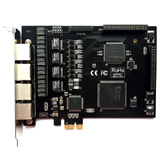

| Index |
|||||||||||
|
SIP : Session Initiation Protocol SIP has the following characteristics: Transport-independent, because SIP can be used with
UDP, TCP, ATM & so on. Protocol design A motivating goal for SIP was to provide a signalling and call setup protocol for IP-based communications that can support a superset of the call processing functions and features present in the public switched telephone network (PSTN). SIP by itself does not define these features; rather, its focus is call-setup and signalling. However, it has been designed to enable the building of such features in network elements known as Proxy Servers and User Agents. These are features that permit familiar telephone-like operations: dialing a number, causing a phone to ring, hearing ringback tones or a busy signal. Implementation and terminology are different in the SIP world but to the end-user, the behavior is similar.
SIP-enabled telephony networks can also implement many of the more advanced call processing features present in Signalling System 7 (SS7), though the two protocols themselves are very different. SS7 is a highly centralized protocol, characterized by a highly complex central network architecture and dumb endpoints (traditional telephone handsets). SIP is a peer-to-peer protocol. As such it requires only a very simple (and thus highly scalable) core network with intelligence distributed to the network edge, embedded in endpoints (terminating devices built in either hardware or software). SIP features are implemented in the communicating endpoints (i.e. at the edge of the network) as opposed to traditional SS7 features, which are implemented in the network. Although many other VoIP signalling protocols exist, SIP is characterized by its proponents as having roots in the IP community rather than the telecom industry. SIP has been standardized and governed primarily by the IETF while the H.323 VoIP protocol has been traditionally more associated with the ITU. However, the two organizations have endorsed both protocols in some fashion. SIP works in concert with several other protocols and is only involved in the signalling portion of a communication session. SIP acts as a carrier for the Session Description Protocol (SDP), which describes the media content of the session, e.g. what IP ports to use, the codec being used etc. In typical use, SIP "sessions" are simply packet streams of the Real-time Transport Protocol (RTP). RTP is the carrier for the actual voice or video content itself. The first proposed standard version (SIP 2.0) was defined in RFC 2543. The protocol was further clarified in RFC 3261, although many implementations are still using interim draft versions. Note that the version number remains 2.0. SIP is similar to HTTP and shares some of its design principles: It is human readable and request-response structured. SIP shares many HTTP status codes, such as the familiar '404 not found'. SIP proponents also claim it to be simpler than H.323. However, some would counter that while SIP originally had a goal of simplicity, in its current state it has become as complex as H.323. Others would argue that SIP is a stateless protocol, hence making it possible to easily implement failover and other features that are difficult in stateful protocols such as H.323. SIP and H.323 are not limited to voice communication but can mediate any kind of communication session from voice to video or future, unrealized applications.
SIP also requires proxy and registrar network elements to work as a practical service. Although two SIP endpoints can communicate without any intervening SIP infrastructure, which is why the protocol is described as peer-to-peer, this approach is impractical for a public service. There are various implementations that can act as proxy and registrar. From the RFCs: "SIP makes use of elements called proxy servers
to help route requests to the user's current location, authenticate
and authorize users for services, implement provider call-routing
policies, and provide features to users." Instant messaging (IM) and presence Some efforts have been made to integrate SIP-based VoIP with the XMPP specification used by Jabber. Most notably Google Talk, which extends XMPP to support voice, plans to integrate SIP. Google's XMPP extension is called Jingle and, like SIP, it acts as a Session Description Protocol carrier. SIP itself defines a method of passing instant messages between endpoints, similar to SMS messages. This is not generally supported by commercial operators.
As envisioned by its originators, SIP's peer-to-peer nature does not enable network-provided services. For example, the network can not easily support legal interception of calls (referred to in the United States by the law governing wiretaps, CALEA). Emergency calls (calls to E911 in the USA) are difficult to route. It is difficult to identify the proper Public Service Answering Point, PSAP because of the inherent mobility of IP end points and the lack of any network location capability. However, as commercial SIP services begin to take off practical solutions to these problems are being proven. Standards being developed by such organizations as 3GPP and 3GPP2 define applications of the basic SIP model which facilitate commercialization and enable support for network-centric capabilities such as CALEA. Many VoIP phone companies allow customers to bring their own SIP devices, as SIP-capable telephone sets, or softphones. The new market for consumer SIP devices continues to expand. The free software community started to provide more and more of the SIP technology required to build both end points as well as proxy and registrar servers leading to a commoditization of the technology, which accelerates global adoption. SIPfoundry has made available and actively develops a variety of SIP stacks, client applications and SDKs, in addition to entire IP PBX solutions that compete in the market against mostly proprietary IP PBX implementations from established vendors. The National Institute of Standards and Technology (NIST), Advanced Networking Technologies Division provides a public domain implementation of the JAVA Standard for SIP JAIN-SIP which serves as a reference implementation for the standard. The stack can work in proxy server or user agent scenarios and has been used in numerous commercial and research projects. It supports RFC 3261 in full and a number of extension RFCs including RFC 3265 (Subscribe / Notify) and RFC 3262 (Provisional Reliable Responses) etc.
-ISDN BRI and ISDN PRI Services |




